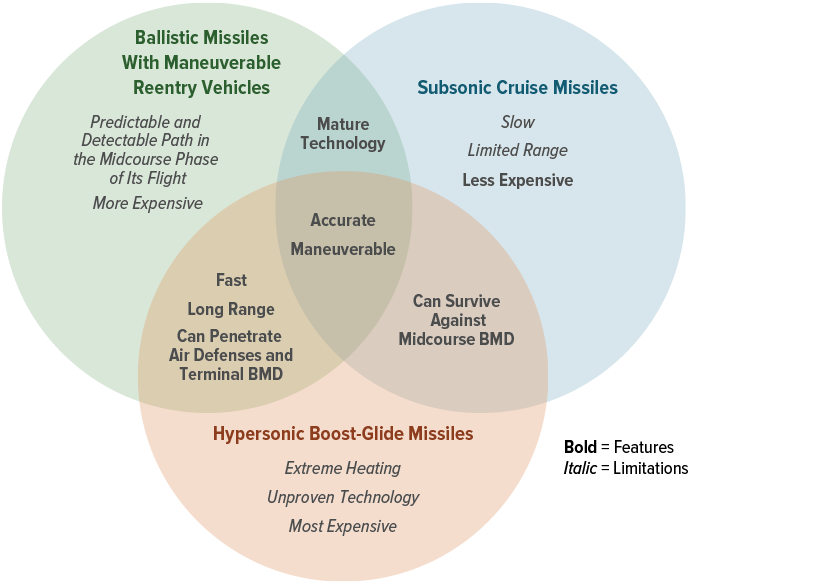Summary
 The Army, Navy, and Air Force are each developing hypersonic missiles—nonnuclear offensive weapons that fly faster than five times the speed of sound and spend most of their flight in the Earth’s atmosphere. Those missiles are intended to be maneuverable and capable of striking targets quickly (in roughly 15 minutes to 30 minutes) from thousands of kilometers away.
The Army, Navy, and Air Force are each developing hypersonic missiles—nonnuclear offensive weapons that fly faster than five times the speed of sound and spend most of their flight in the Earth’s atmosphere. Those missiles are intended to be maneuverable and capable of striking targets quickly (in roughly 15 minutes to 30 minutes) from thousands of kilometers away.In this report, the Congressional Budget Office analyzes the hypersonic weapons being developed by the U.S. military and compares them with less expensive existing or potential weapons that might fill similar roles, such as ballistic missiles or cruise missiles. CBO reached the following conclusions:Technological challenges must still be overcome to field hypersonic missiles. The fundamental remaining challenge involves managing the extreme heat that hypersonic missiles are exposed to by traveling at high speeds in the atmosphere for most of their flight (unlike cruise missiles, which fly in the atmosphere at lower speeds, or ballistic missiles, which mainly fly above the atmosphere). Shielding hypersonic missiles’ sensitive electronics, understanding how various materials perform, and predicting aerodynamics at sustained temperatures as high as 3,000° Fahrenheit require extensive flight testing. Tests are ongoing, but failures in recent years have delayed progress.
Both hypersonic and ballistic missiles are well-suited to operate outside potential adversaries’ antiaccess and area-denial (A2/AD), or “keep-out,” zones. The Department of Defense has developed a strategy to use accurate, long-range, high-speed missiles early in a conflict to neutralize the A2/AD zones being developed by potential adversaries, such as China and Russia. Both hypersonic missiles and ballistic missiles equipped with maneuverable warheads could provide the combination of speed, accuracy, range, and survivability (the ability to reach a target without being intercepted) that would be useful in the military scenarios CBO considered. However, many missions do not require such rapid strikes. For those missions, less costly alternatives to both hypersonic and ballistic missiles exist, including subsonic cruise missiles. Hypersonic weapons would mainly be useful to address threats that were both well-defended and extremely time-sensitive.
Hypersonic missiles would probably not be more survivable than ballistic missiles with maneuverable warheads in a conflict, unless the ballistic missiles encountered highly effective long-range defenses. Hypersonic missiles can neutralize long-range (midcourse) defenses because they fly inside the atmosphere, below the altitude where midcourse ballistic missile defenses typically operate. Hypersonic weapons can also maneuver unpredictably at high speeds to counter short-range defenses near a target, making it harder to track and intercept them. Ballistic missiles are also difficult to defend against, particularly if they are equipped with countermeasures to confuse midcourse missile defenses and maneuverable warheads to defeat short-range missile defenses. Only very effective long-range defenses would be likely to threaten ballistic missiles in midcourse; to date, no potential U.S. adversaries have deployed such defenses.
Hypersonic missiles could cost one-third more to procure and field than ballistic missiles of the same range with maneuverable warheads. CBO estimates that buying 300 ground- or sea-launched, intermediate-range ballistic missiles with maneuverable warheads and sustaining the missile system for 20 years would cost a total of $13.4 billion (in 2023 dollars). The same number of comparable hypersonic missiles would cost about one-third more, $17.9 billion, CBO estimates. (Neither estimate includes the cost overruns that are often associated with technically challenging programs.) The higher costs for hypersonic missiles partly reflect the complexity of building systems that can withstand the heat of hypersonic flight.
Comparison of the Features and Limitations of Hypersonic Missiles and Alternatives

BMD = ballistic missile defense.
6.51 MB
No comments:
Post a Comment